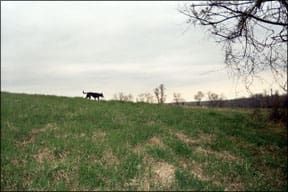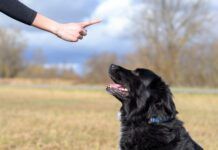I can empathize with Susan Aceti, author of the article that follows. Prior to becoming a professional dog trainer, I, too, had a dog – a Bull Terrier – who loved to run, and who didn’t have a reliable recall (despite high scores in the obedience ring). I, too, recognized the joy my dog experienced when she had the opportunity to run like the wind. I, too, was willing to take the risk of allowing Caper off leash, in an appropriately little-traveled open space. Thankfully, I never had cause to regret it. Some may be critical of Susan for not working harder at that “perfect recall” before letting her dog off leash, or for her unwillingness to use more coercive methods that might ensure a more prompt response, albeit at the risk to relationship. Not me. I admire her for her commitment to a dog with a difficult start in life, for the tremendous progress she’s made with Molly, and for her ability to weigh risks and make difficult but measured choices in order to give her dog the quality of life she deserves.
– Pat Miller, Training Editor, Whole Dog Journal
My dog, Molly, runs like the wind. When she sprints at top speed, her normally upright ears flow back against her head and her tail balances her like a rudder on a boat. When I see her run off leash, it is impossible for me not to appreciate the beautiful, graceful way she moves.

288
Until recently, though, it was not often that I got to see her run. While some people are blessed with dogs who wiggle with happiness at meeting strangers and other dogs, Molly is different. At six months, she was rescued from being locked in a basement with no dog food. As a first time owner, I was blissfully unaware of the behavior problems that a severely neglected dog can have. Some dogs can overcome a difficult beginning, but for Molly the combination of a bad environment and a fearful temperament created a dog who protects herself by aggressively warning off any stranger.
During the past three years, Molly has overcome some of her fear. I use positive reinforcement for calm behavior and I make sure I don’t put her into situations she can’t handle.
That management means staying away from off-leash dog parks and most other off-leash areas. During the rare times I let her off leash in small wooded areas in the past, I was tormented by the fear that she would encounter someone and act aggressively or even bite.
Molly has never bitten anyone and off leash, is much more likely to run away then bite – but I still worry. In addition, Molly’s desire to chase prey can easily trump staying with her loving owner. I could be holding a raw, bloody steak and Molly would still dash after a deer with scarcely a look in my direction.
Since I don’t believe in hurting my dog, using a shock collar to keep her with me is out of the question. And, if she began to associate shocks with strangers it would quickly undo all of the tremendous progress she’s made.
So without a fenced yard, we walk – miles and miles of walking – as I try to give my high-energy dog enough exercise. But even several hours of walking leaves her ready for several hours more. Molly rarely has the opportunity to run like the wind. I know that adequate exercise is part of the prescription for helping a reactive dog like Molly but her reactivity is precisely the factor that limits where and how I can exercise her.
A wild place
About a year ago, though, one thing changed. A co-worker at a new job invited Molly and me to visit the local nature conservancy where my co-worker rents a house. The conservancy’s 200-plus acres are open to the public but most of the time there are few visitors around. The conservancy is unfenced but far bigger than the other areas I had been to before and on one side it abuts a state forest.
After working on a reliable recall for many months and walking the conservancy grounds with Molly on leash for several more months, the day finally came when I took her leash off. At first, it was nerve-wracking for me. Molly sometimes stayed in my general vicinity as we walked, but also took off to explore. Those minutes she was gone seemed like torturous hours to me. Was she lost, out of ear shot, injured in some way? I’d call and call her, cursing myself for being a horrible, irresponsible owner. Each time she’d come back – maybe not right away – but she’d come back. She would be galloping towards me with her tongue hanging out – sometimes running so fast she’d overshoot where I was standing and she’d have to skid around and come back.
And then, one day, watching her with her nose to the ground, tracking some creature, I had an epiphany. I am more vulnerable in this environment than she is. She is equipped with incredible hearing, an amazing sense of smell, an extraordinarily agile body, and really big, sharp teeth. Really, really big teeth. My nephew – a star on the football field – pointed out recently that Molly is always equipped with cleats and never has to change in or out of warmer clothes.
In this environment, my physical abilities pale compared to hers. I’m not terribly clumsy, but I’m far more likely to stumble over a rock or log than she is. Sometimes, without the telltale jingle of her tags, I’d have a hard time locating her. And getting lost? I always figured I was the one looking for her if she went out of my sight. I soon learned that standing still and having her find me was far more successful than crashing through the woods trying to find her.
Perhaps most significantly, I came to realize that off leash there is a different tenor in our interaction. When she’s on leash, I choose which way to walk, when I would like her to stop sniffing, and whether to turn around if there’s something I think she might find threatening. As gently as I use the leash, there’s still a sense of control and containment about it. In a pinch, I can get her away from some place or some thing with nothing other than the leash.
But with her off leash, there is a more genuine sense of partnership. I learned slowly to trust Molly to come back to me. She now checks in with me during off-leash romps for a “Hey, how ya doing?” and a treat. She will also periodically simply turn to see where I am, which I take as part checking on me, and part “Hurry up, slowpoke!”
I feel a keen sense of companionship with Molly at these times that I imagine cowboys out West must have felt riding on their horses with a dog trotting by their side. I also feel like she’s watching out for me – and I’m perfectly fine with the nonanthropomorphic thought that she’s guarding me because I’m a resource for her.
This companionship and security belies the idea that so many people seem to have that cooperation between human and dog can only be forced through punitive measures – “If my dog doesn’t come back when I call, I’m going to shock her until she does.” My co-worker once noted that I seemed surprised every time Molly chose to come back and check in with me. I guess I also used to think that she wouldn’t offer her cooperation voluntarily. Well, she does offer it and it is incredibly satisfying.
I know that there is danger in letting her off leash and I take every precaution I can to avoid it. But when I see Molly in the woods, her joy is absolutely undeniable. The delight in her eyes and in her body language is overwhelming. She is a fish in water, a bird in the sky, a pig in mud. This can be a tough world, for humans and animals, and joy can be hard to come by. Despite the risks, I will continue to let her run off leash, because my dog, Molly, runs like the wind.
Susan Aceti lives in Maryland with Molly and two cats who put up with Molly. When not exercising the dog, Susan works for a nonprofit that promotes healthy homes.






